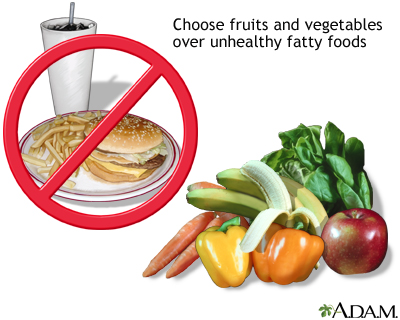Familial hypertriglyceridemia
Type IV hyperlipoproteinemiaFamilial hypertriglyceridemia is a common disorder passed down through families. It causes a higher-than-normal level of triglycerides (a type of fat) in a person's blood.
Causes
Familial hypertriglyceridemia is most likely caused by genetic variants combined with environmental factors. As a result, the condition clusters in families. How severe the disorder is can vary based on sex, age, hormone use, and dietary factors.
People with this condition also have high levels of very low density lipoprotein (VLDL). LDL cholesterol and HDL cholesterol are often low.
Very low density lipoprotein
VLDL stands for very low density lipoprotein. Lipoproteins are made up of cholesterol, triglycerides, and proteins. They move cholesterol, triglyce...

In most cases, familial hypertriglyceridemia is not noticeable until puberty or early adulthood. Obesity, hyperglycemia (high blood glucose levels), and high levels of insulin are often present as well. These factors may cause even higher triglyceride levels. Alcohol, a diet high in carbohydrates, and estrogen use can make the condition worse.
You are more likely to have this condition if you have a family history of hypertriglyceridemia or heart disease before age 50.
Heart disease
Coronary heart disease is a narrowing of the blood vessels that supply blood and oxygen to the heart. Coronary heart disease (CHD) is also called co...

Symptoms
You may not notice any symptoms. Some people with the condition may have coronary artery disease at an early age.
Exams and Tests
Your health care provider will perform a physical exam and ask about your family history and symptoms.
If you have a family history of this condition, you should have blood tests to check very low density lipoprotein (VLDL) and triglyceride levels. Blood tests most often show a mild to moderate increase in triglycerides (about 200 to 500 mg/dL).
Very low density lipoprotein
VLDL stands for very low density lipoprotein. Lipoproteins are made up of cholesterol, triglycerides, and proteins. They move cholesterol, triglyce...

A coronary risk profile may also be done.
Treatment
The goal of treatment is to control conditions that can raise triglyceride levels. These include obesity, hypothyroidism, and diabetes.
Obesity
Overweight and obesity mean having a weight than is higher than what is healthy for a given height. A person may be overweight from extra muscle, bo...

Hypothyroidism
Hypothyroidism is a condition in which the thyroid gland does not make enough thyroid hormone. This condition is often called underactive thyroid....

Diabetes
Diabetes is a long-term (chronic) disease in which the body cannot regulate the amount of sugar in the blood.

Your provider may tell you not to drink alcohol. Certain birth control pills can raise triglyceride levels. Talk to your provider about your risk when deciding whether to take these medicines.
Treatment also involves avoiding excess calories and foods high in saturated fats and carbohydrates.
Foods high in saturated fats and carboh...
A healthy diet is an important factor in reducing your risk for heart disease.

You may need to take medicine if your triglyceride levels stay high, even after making diet changes. Nicotinic acid, gemfibrozil, and fenofibrate will lower triglyceride levels in people with this condition.
Outlook (Prognosis)
Losing weight and keeping diabetes under control helps improve the outcome.
Possible Complications
Complications may include:
- Pancreatitis
- Coronary artery disease
Prevention
Screening family members for high triglycerides may detect the disease early.
High triglycerides
Cholesterol is a fat (also called a lipid) that your body needs to work properly. Too much bad cholesterol in your blood can increase your chance of...

References
Genest J, Mora S, Libby P. Lipoprotein disorders and cardiovascular disease. In: Libby P, Bonow RO, Mann DL, Tomaselli GF, Bhatt DL, Solomon SD, eds. Braunwald's Heart Disease: A Textbook of Cardiovascular Medicine. 12th ed. Philadelphia, PA: Elsevier; 2022:chap 27.
Robinson JG. Disorders of lipid metabolism. In: Goldman L, Cooney KA, eds. Goldman-Cecil Medicine. 27th ed. Philadelphia, PA: Elsevier; 2024:chap 190.
-
Healthy diet - illustration
For a healthy diet, replace unhealthy and fattening foods with healthier alternatives, such as fresh fruits and vegetables.
Healthy diet
illustration
Review Date: 5/8/2024
Reviewed By: Thomas S. Metkus, MD, Assistant Professor of Medicine and Surgery, Johns Hopkins University School of Medicine, Baltimore, MD. Also reviewed by David C. Dugdale, MD, Medical Director, Brenda Conaway, Editorial Director, and the A.D.A.M. Editorial team.



